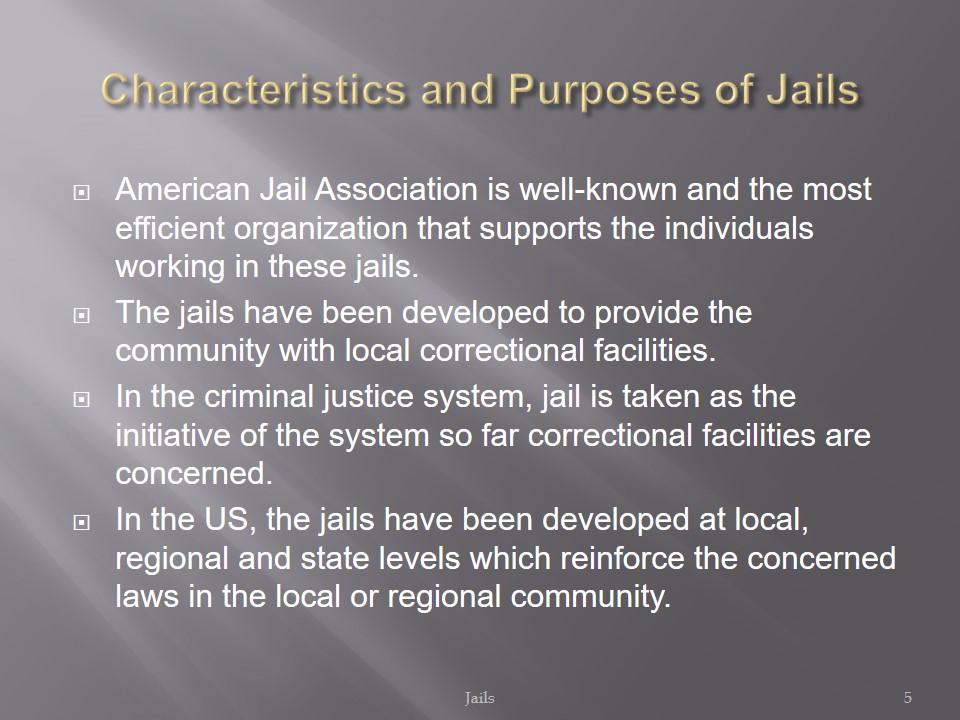Characteristics and Purposes of Prisons
In the American Criminal Justice System, Federal Bureau of Prisons, commonly known as FBOP, has been making its major contribution for the smooth execution of prisons in various regions of the USA.
The prisons working under this organization of the US are characterized by the shelters for offenders providing them friendly and safe environment so as to induce the elements of disliking for crime among them.
These prisons deal with federal prisoners and provide them with the correctional facilities in their related areas.
In the prisons, the prisoners are subjected to predefined corrections and punishments in order to ensure the public safety.
The prisons in the US have been developed with an aspect of judicial districts so as to define the jurisdiction of each prison.
FBOP has developed some programs in order to interact with community for aiding in crime control in its related area.
In this model of chain prisons, prisoners are educated for raising their social morals (FBOP, n.d.).
The major motif behind the development and operational activities of these prisons is to ensure the public safety and maintain the peace process in the concerned region.
The various educational and training programs in the prisons have been conducted to produce harmony between the staff and the prisoners.
The prisoners’ misconduct is corrected through legal corrections as defined by the law.
It has also been argued by the theorist of criminology that the scenario of the prisons impacts mainly the behavioral psychology of inmates (Camp et al. 2003).
FBOP has been working since 1930, based in Washington. 85% of federal inmates are confined in the prisons operating under the same organization and the total number of FBOP’s employees are 35,000 almost.



Characteristics and Purposes of Jails
- American Jail Association is well-known and the most efficient organization that supports the individuals working in these jails.
- The jails have been developed to provide the community with local correctional facilities.
- In the criminal justice system, jail is taken as the initiative of the system so far correctional facilities are concerned.
- In the US, the jails have been developed at local, regional and state levels which reinforce the concerned laws in the local or regional community.
- Initially, the jails were developed to destroy the hierarchy of feudalism prevailing in the US.
- It has also been reported that the prisoners in jail suffer from mental illness more than those in prisons.
- The basic rationale behind the development of jails in the US criminal justice system is to cover the issues remaining from prisons.
- Jails have been constructed in the US at local level so as to confine the area of criminal actions and crimes (Kerle, 2004).


Correctional Facility
- Correctional facility is the tool of avoiding future misconducts and dissolving criminal thinking.
- The American Correctional Association is the major organization, serving in this concern.
- This organization has ensured the easy approach of the community towards the correctional facility by offering us with various modern tools.
- It works in several areas, such as professional development, community counseling, prisoners’ training and introducing new technologies (American Correctional Association, n.d.).

Difference Between Jails and Prisons
Jail is meant as local correctional facility whereas the prisons are under the jurisdiction of state and federal government.
Both are the part of the US criminal justice system that also includes courts, law enforcement and crime labs.
Jail is designed for short period, hence it can serve the community with short correctional facility. On the other side, prisons characterize the life-long duration for prisoners.
In jails, the prisoners have some access to social life, while the prisoners in prisons become segregated from the whole society.
In jails, the prisoners are not necessarily gone through legal trials, while in prisons, the prisoners are kept after complete probation and trials.
A prison is more roomy in nature because it adjusts more and more prisoners due to a principle that prisoners are separately kept in various areas of prisons to their respective nature of crimes. However, in jail, it is not so and the less figure of prisoners can be managed in a jail.
Prison has another exception that it can adjust the prisoners with capital punishment.
A prison is operated under strict security so as to avoid an in-house violence, whereas in jails, the environment is open to prisoners and they can meet with each other without any legal obligation.
Jail is the baseline of the US criminal justice system, while the prison is the major frontline of that system.
Jails are constructed at local and small levels and operated through local and country laws, whereas prisons are operated through state and federal laws.
The low security prisons present the environment of hotel because of absence of strict laws.
Prisons differ from jails also because they have different management that are trained under different scenarios and have different skills for operating prisoners.
Board of governors monitor the efficiency of prison’s management while no such administration exists in jails.
In prisons, the prisoners suffer from increased social and political issues due to sharing of cells and a major dilemma of mental health is also abundant in the prisoners of prisons. In jails, this issue does not report such potency because of short duration and relaxed environment (Smith, 2003).




References
American Correctional Association. (n.d). Web.
Camp, S., Gaes, Langan & Saylor, W. G. (2003). “The Influence of Prisons on Inmate Misconduct: A multilevel Investigation”. Justice Quarterly. FBOP, Washington; DC.
Federal Bureau of Prisons. (n.d.). “Protecting Society and Reducing Crime”. Web.
Kerle, K. E. (2004). “Exploring Jail Operations”. American Jail Association.
Smith, S. E. (2003). “What is the Difference Between Jail and Prison?” WiseGreek. Web.


